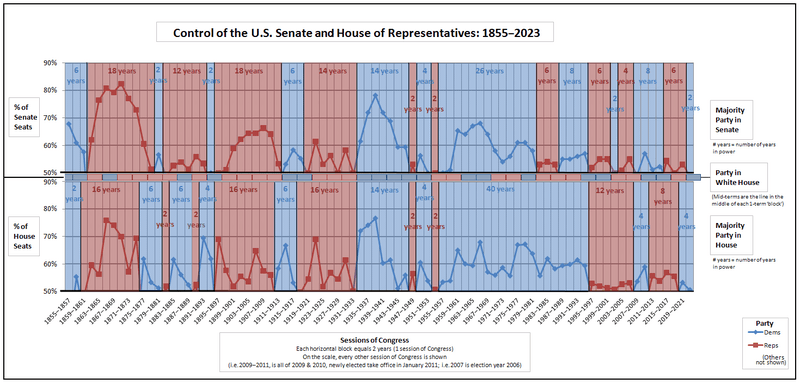Image: Combined--Control of the U.S. House of Representatives - Control of the U.S. Senate

Description: Presidents, all elections Graph of Control of the U.S. Senate (top - see expanded graph) and House of Representatives (bottom - see expanded graph) from 1855-2015, including control of the Executive (middle bar - see expanded detailed graph of President election history). This graph was created by simply cutting & pasting parts of the two source documents. Half of each graph was eliminated, but little information is lost as the bottom half of each graph typically shows the reciprocal. The information that has been lost deals with 3rd Party percentages. Justification for this removal is to make the combined graph more clear and concise, with 3rd Party influence often having little impact on control over each house. Along with a simple majority of greater than 50%, other important thresholds have to do with attaining a supermajority. The Constitution requires a two-thirds majority for certain critical actions such as passing a bill that has been vetoed by the President. A 2/3rds supermajority is also required for the Senate to remove an official that has been impeached by the House (by simple majority). Senate rules also require a 3/5ths (60%) supermajority for ending a filibuster through cloture. Prior to 1975, the requirement was a 2/3rds supermajority. The most powerful position a party can be in is to hold a 2/3rds supermajority in both the House and Senate, along with holding the Presidency. This has been a rare occurrence for either party in both the 1800s and 1900s. Neither party has yet achieved this so far in the 2000s. The starting point of this graph is not arbitrary. The 34th Congress that started in 1855 marked the rise of the Republican Party in the wake of the Whig Party and the Free Soil Party in particular. The Republican Party marks its founding year as 1854. 1855 was the start of the stable two-party system of Democrats and Republicans. Since that time, the majority party in either chamber has been from one of these two. Millard Fillmore, whose term ended in 1853, was the last Whig President. All Presidents after him have been Democrat or Republican. For a graph of the history of popular votes in US presidential elections, see File:PartyVotes.png.
Title: Combined--Control of the U.S. House of Representatives - Control of the U.S. Senate
Credit: File:Control of the U.S. Senate.PNG File:Control of the U.S. House of Representatives.PNG
Author: ChrisnHouston
Usage Terms: Creative Commons Attribution-Share Alike 3.0
License: CC BY-SA 3.0
License Link: http://creativecommons.org/licenses/by-sa/3.0
Attribution Required?: Yes
Image usage
The following 4 pages link to this image:

